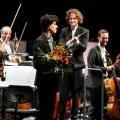Search the Community
Showing results for tags 'mosaic'.
-
I went over this piece once a teacher I had (on counterpoint) told me I should notate the different tempi for each instrument. What do you think? The world of polyrhythm-polytempi is wide. This is a canon in prolatio where every line is the same at different ratios.
- 1 reply
-
- canon
- prolationum
-
(and 4 more)
Tagged with:
-
Hello everybody! It tooks ages to get some inspiration and it feels very satisfying to finally post some new music... This composition is going to be submitted to a Dutch concours with the theme ''Lang zullen we ronddraaien.'' This can be translated like: The earth will rotate for still much time. I interpreted the music like we become crazy, which means ''We draaien door.'' The poem is written by me and its theme is the refugees crisis. The form is Mosaic Form. Please tell me your opinion about the music! Feedback is appreciated as well. Maarten We draaien door Kijk om je heen. Voor je, achter je, links van je, rechts van je. Die man, die vrouw Die jij hier ziet zijn bevoorrecht. Dat kind Dat jij opmerkt, heeft geluk Denk na. We beklagen ongeremd Het weer, het eten, het drinken, gisteren, vandaag, morgen; Anderen. Die man, die vrouw, dat kind, Zij en wij leven in een bijna-utopie Die we liever niet met anderen delen. Denk na! Andere mannen, vrouwen, kinderen Die juist nú hulp nodig hebben, Keren wij de rug toe. Ons geluk delen met medemensen Die de hel meemaakten; Lijkt een stap te ver Voor sommigen van ons. We draaien door! Het duizelt me. - Maarten Bauer, 12 september 2017. TRANSLATION We become crazy Look around you In front of you, behind you, left from you, right from you. That man, that woman Who you see there are privileged. That child Who you notice, is lucky. Think. We complaint unbulliently of The weather, the food, the drinks, yesterday, today, tomorrow; Others. That man, that woman, that child They and we live in an 'almost utopia' Which we preferably do bot share with others. Think! We turn our backs upon Other men, women, children Who need help right now. Sharing our fortune with neighbours, Who experiened the Hell, Seems to go too far For some of us. We become crazy! I get dizzy from it. - Maarten Bauer, 12 september 2017.
-
This was just an idea, and built on superimposed and overlapped small parts.
-
Hi... Since I learnt of the Mosaic Form from Stravinsky (Symphony of Wind Instruments), among others, I fell in love with it. In it, there are a number of short parts that the composer put together in different manners. So, the concept of classical forms, and the concept of repetition is simply another one. This piece takes the idea of the labyrinth from the other side (compared to the one in the prepared piano piece). This one looks inwards and I wanted to write something "intimate". So, this work is written for another kind of prepared piano: it should be played with the una corda pedal all the time, and with a fabric on the strings of the piano, to get the sound. There are 11 fragments using always pentatonic scales (some of them with two scales at a time). There are two expositions of the material: Firstly in a sort of "disorder" (as looking for the exit), secondly in the "right" order. Details can be seen in the final page of the score. I am aware that this Mosaic Form is something unexpected (in fact that's its main purpose). You can't compare it to a AB or ABA form, or whatever. Its organization takes its essentials in other concepts. LABYRINTH 2 - SCORE.pdf
- 3 replies
-
- pentatonic
- fabric
-
(and 4 more)
Tagged with:


